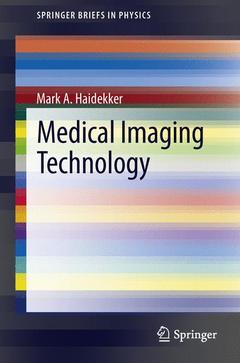Description
Medical Imaging Technology, 2013
SpringerBriefs in Physics Series
Author: Haidekker Mark A
Language: English
Subjects for Medical Imaging Technology:
Publication date: 04-2013
129 p. · 15.5x23.5 cm · Paperback
129 p. · 15.5x23.5 cm · Paperback
Description
/li>Contents
/li>Biography
/li>Comment
/li>
Biomedical imaging is a relatively young discipline that started with Conrad Wilhelm Roentgen?s discovery of the x-ray in 1895. X-ray imaging was rapidly adopted in hospitals around the world. However, it was the advent of computerized data and image processing that made revolutionary new imaging modalities possible. Today, cross-sections and three-dimensional reconstructions of the organs inside the human body is possible with unprecedented speed, detail and quality.
This book provides an introduction into the principles of image formation of key medical imaging modalities: X-ray projection imaging, x-ray computed tomography, magnetic resonance imaging, ultrasound imaging, and radionuclide imaging. Recent developments in optical imaging are also covered. For each imaging modality, the introduction into the physical principles and sources of contrast is provided, followed by the methods of image formation, engineering aspects of the imaging devices, and a discussion of strengths and limitations of the modality.
With this book, the reader gains a broad foundation of understanding and knowledge how today?s medical imaging devices operate. In addition, the chapters in this book can serve as an entry point for the in-depth study of individual modalities by providing the essential basics of each modality in a comprehensive and easy-to-understand manner. As such, this book is equally attractive as a textbook for undergraduate or graduate biomedical imaging classes and as a reference and self-study guide for more specialized in-depth studies.
This book provides an introduction into the principles of image formation of key medical imaging modalities: X-ray projection imaging, x-ray computed tomography, magnetic resonance imaging, ultrasound imaging, and radionuclide imaging. Recent developments in optical imaging are also covered. For each imaging modality, the introduction into the physical principles and sources of contrast is provided, followed by the methods of image formation, engineering aspects of the imaging devices, and a discussion of strengths and limitations of the modality.
With this book, the reader gains a broad foundation of understanding and knowledge how today?s medical imaging devices operate. In addition, the chapters in this book can serve as an entry point for the in-depth study of individual modalities by providing the essential basics of each modality in a comprehensive and easy-to-understand manner. As such, this book is equally attractive as a textbook for undergraduate or graduate biomedical imaging classes and as a reference and self-study guide for more specialized in-depth studies.
Introduction.- X-ray Projection Imaging.- Computed Tomography.- Nuclear Imaging.- Magnetic Resonance Imaging.- Ultrasound Imaging.- Trends in Medical Imaging Technology.- References.- Index.
Dr. Mark A. Haidekker received an education in Electrical Engineering at the University of Hannover in Germany and a PhD degree in computer science from the University of Bremen Germany. His research originally was focused on algorithm development in computer aided radiology, notably the improvement of estimation of the individual fracture risk in osteoporosis based on CT images.
Between 1999 and 2002, he was employed at the University of California, San Diego, first as postdoctoral research fellow and later as Assistant Research Scientist. In 2002, he assumed a position as Assistant Professor at the University of Missouri in Columbia. During this time, his research shifted towards biomechanical properties of the cell membrane, and in the process, he developed new fluorescent reporters (molecular rotors) for the real-time imaging of microviscosity and local shear stress in biomembranes and biofluids.
Since 2007, he is employed as Associate Professor in the College of engineering at the University of Georgia. His research involves x-ray tomography, fluorescent and hyperspectral imaging.
Between 1999 and 2002, he was employed at the University of California, San Diego, first as postdoctoral research fellow and later as Assistant Research Scientist. In 2002, he assumed a position as Assistant Professor at the University of Missouri in Columbia. During this time, his research shifted towards biomechanical properties of the cell membrane, and in the process, he developed new fluorescent reporters (molecular rotors) for the real-time imaging of microviscosity and local shear stress in biomembranes and biofluids.
Since 2007, he is employed as Associate Professor in the College of engineering at the University of Georgia. His research involves x-ray tomography, fluorescent and hyperspectral imaging.
For the first time, modern medical imaging technology is covered in a concise, short format book Provides an introduction into the principles of image formation of key medical imaging modalities such as X-ray projection imaging and x-ray computed tomography Can be used as a supplemental text in undergraduate or graduate biomedical imaging classes Serves as an entry point for the in-depth study of individual modalities by providing the essential basics of each modality in a comprehensive and easy-to-understand manner
© 2024 LAVOISIER S.A.S.




